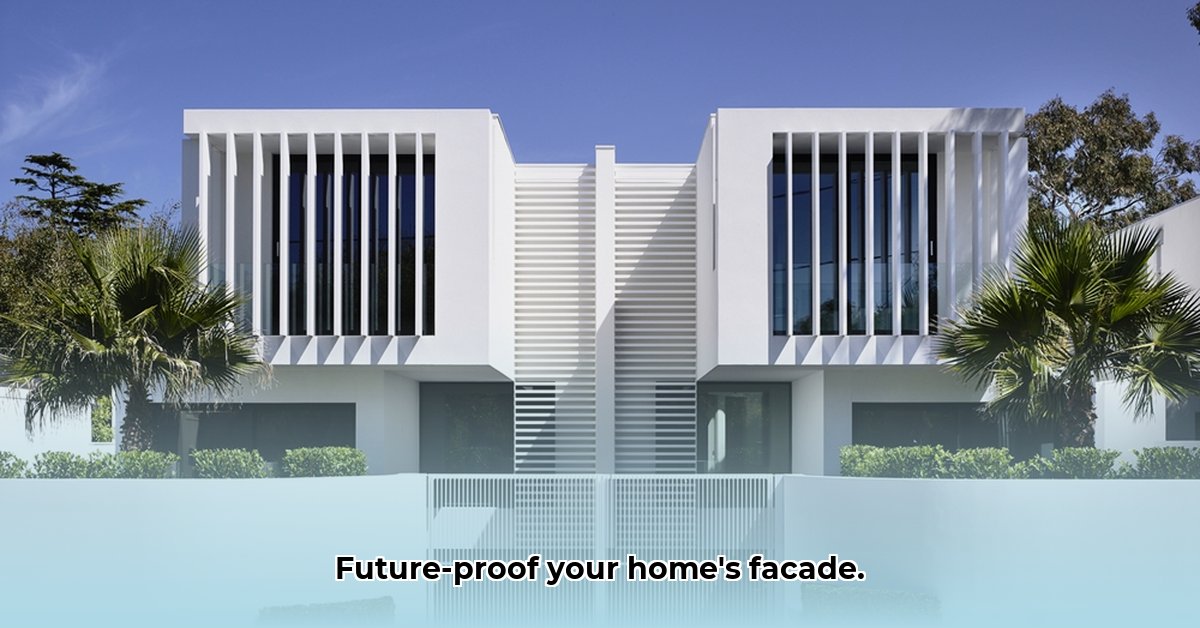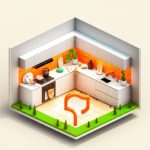Want a home exterior that wows? This guide is your shortcut to a stunning, modern front house design. We’ll cover the hottest trends for 2025, showcase eco-friendly materials, and guide you through designing your dream facade. Whether you’re a homeowner, architect, or builder, you’ll find expert advice and practical tips to create a stylish and sustainable home. For more on brick options, check out this guide on modern brick designs. Get ready to transform your curb appeal with modern design that lasts.
Modern Front Design of House: 2025 Trends & Ideas
Creating a modern home exterior involves crafting a space that reflects your style and complements its surroundings. Let’s explore the trends shaping modern house fronts in 2025, including landscaping integration, minimalist design, and smart home technology.
Natural Light: Maximizing Window Size
Consider what grabs your attention in a beautiful home. Light often floods the space. Modern designs prioritize maximizing natural light, which is vital for creating airy interiors. Large windows, sometimes stretching from floor to ceiling, are key. They brighten the interior, making rooms feel bigger. It’s about creating a connection between your indoor living space and the outdoors. This openness is part of what makes a modern home feel fresh. South-facing windows are great for capturing light. Skylights can also transform a room.
Sustainable Materials: Eco-Friendly Choices Take Center Stage
We’re all aware of our impact on the planet. That’s why sustainable materials are increasingly popular for modern homes. Options include reclaimed wood, ethically sourced timber, and locally quarried stone. These materials reduce your carbon footprint and support local economies, plus they offer visual appeal. They add texture and unique character to the house’s exterior. Natural materials also age beautifully, developing a patina over time, unlike synthetic alternatives that fade or crack. Consider bamboo for siding, known for its rapid growth and durability.
Minimalist Design: Embracing Simplicity
Modern design often leans toward minimalism: clean lines, uncluttered surfaces, and a focus on essential elements. This allows the architecture, the materials, and the landscaping to shine. Imagine your home’s exterior as a curated work of art—each element thoughtfully chosen. The result is a sophisticated and timeless look, focusing on functionality and visual harmony. Neutral color palettes, such as whites, grays, and beiges, enhance the minimalist aesthetic.
Smart Homes: Technology Meets Style
Smart home technology is integrated into modern homes, offering convenience and sophistication. Features like automated lighting, climate control, and integrated security systems add convenience. Consider the costs and security implications before jumping in. Weigh the convenience against the price tag and the need for a robust security system. Smart thermostats can adjust temperatures based on occupancy, saving energy.
Regional Flair: Adapting to Your Surroundings
A great modern design understands its context. A beach house might use weathered wood and a relaxed color palette, while a tropical home might feature bamboo or teak. This approach gives each home a unique personality, reflecting the local environment. It’s about creating a home that feels beautiful and at ease within its setting. In desert climates, consider incorporating elements that provide shade and reduce heat gain.
Biophilic Design: Bringing Nature Home
Biophilic design connects us more deeply with nature. In modern home design, this translates into thoughtful landscaping, using natural materials, and creating outdoor living spaces that are extensions of the interior. Think about inviting patios, balconies adorned with lush plants, or exquisite gardens. These spaces blur the lines between inside and outside, creating a calm atmosphere. Green roofs can also enhance the connection with nature while providing insulation.
Your Modern Facade: A Step-by-Step Guide
Creating your dream modern home exterior involves planning. Here’s a roadmap:
- Inspiration and Research: Explore magazines, websites, and neighborhoods. Get a feel for the styles and materials that appeal to you.
- Initial Sketches and Planning: Start with basic sketches. Think about how the design will interact with its surroundings, neighboring homes, and the overall neighborhood aesthetic.
- Seek Professional Guidance: Consulting an architect or designer is recommended. They can help refine your vision, ensuring the design is aesthetically pleasing and structurally sound.
- Material Selection: Choose durable and sustainable materials that align with your aesthetic preferences and budget. Explore the pros and cons of various options.
- Illuminate Your Space: Plan interior and exterior lighting to create ambiance and highlight architectural features.
- Landscaping Integration: Integrate gardens or outdoor living spaces to create a cohesive look.
Modern Materials: Weighing the Pros and Cons
Choosing the right materials is crucial. Here’s a quick look at some popular options:
| Material | Pros | Cons |
|---|---|---|
| Reclaimed Wood | Eco-friendly, unique character, adds warmth, visually appealing | Can be pricier than new wood, may require more maintenance, availability may vary |
| Natural Stone | Durable, weather-resistant, classic look, adds elegance | Can be heavy, potentially costly, professional installation often needed, some types may be prone to weathering in certain climates |
| Concrete | Versatile, durable, modern aesthetic, relatively low maintenance | Can look monotonous if not used creatively, can be prone to cracking in extreme temperatures |
| Metal Cladding | Modern aesthetic, low maintenance, sustainable options available, fire-resistant | Can be expensive, requires proper care to prevent corrosion, can be noisy during rainstorms |
| Brick | Durable, fire-resistant, low maintenance, classic aesthetic | Can be expensive, limited color options, can be susceptible to moisture damage if not properly sealed |
The key is choosing materials that align with your style, budget, and climate. Experiment and combine different materials to achieve a unique and personalized look. The best modern home exterior is both stylish and undeniably you.
Incorporating Smart Home Technology into Modern House Exteriors
Equipping your home with smart technology can be pricey. However, you can enhance your home’s exterior without breaking the bank. It’s possible to enhance both the aesthetics and functionality of your modern front house design with smart home additions.
Exterior Smart Tech: Upgrades for Curb Appeal
Strategically plan to maximize impact for minimum expense. Think of building your smart home ecosystem gradually.
- Smart home technology enhances curb appeal
- Strategic planning minimizes costs.
- Prioritizing essential features is best.
Smart Lighting: Setting the Mood
Smart lighting is a fantastic place to start. Replacing standard exterior lighting fixtures with smart LED bulbs is affordable. These bulbs offer energy savings and allow for remote control and automated scheduling. Set your lights to turn on as you approach your house at night, creating a welcoming ambiance. Program them to automatically switch off at dawn. This looks great and contributes to energy savings. Consider installing pathway lighting that automatically adjusts brightness based on ambient light levels.
Smart Security: Peace of Mind
Smart doorbells with cameras provide real-time video surveillance and remote access. Check who’s at the door, even when you’re not home. Smart floodlights, triggered by motion sensors, add security and deterrent capabilities. These additions boost security without a major financial commitment. Integrate your security system with your smartphone for remote monitoring and control.
Choosing the Right System: DIY vs. Professional
For budget-conscious homeowners, a DIY approach is a good starting point. Many smart devices are user-friendly and require minimal technical expertise for installation. If you’re aiming for a fully integrated system, or have concerns about DIY installation, consider engaging a professional smart home integrator. Yes, there will be additional costs, but the peace of mind and assurance of seamless integration can be worth the investment. Research local integrators and compare quotes before making a decision.
Future-Proofing Your Smart Home Exterior
A crucial element often overlooked when integrating smart tech is future-proofing. When planning your exterior enhancements, consider installing additional wiring conduits or even data lines. These small additions may seem unnecessary now, but they’ll save you expense when upgrading or expanding your smart home system in the future. Consider installing a central hub for your smart home devices to ensure compatibility and ease of control.
Modern Front House Design Elements: Seamless Integration
A well-designed exterior can highlight your smart features. Recessed lighting integrated into the home’s façade can subtly showcase your smart lighting system. Consider a minimalist smart doorbell that complements the architectural style of your home. The goal is seamless integration. Ensure that your smart home features are compatible with your overall aesthetic and don’t detract from the design. Consider concealing wiring and other components to maintain a clean and uncluttered appearance.
- Glass Tile Shower Ideas to Create a Stunning Bathroom Space - December 7, 2025
- Glass Wall Tile Ideas for Kitchens and Bathrooms - December 6, 2025
- Glass Tile Bathroom: Create a Beautiful, Easy-Clean Space - December 5, 2025










